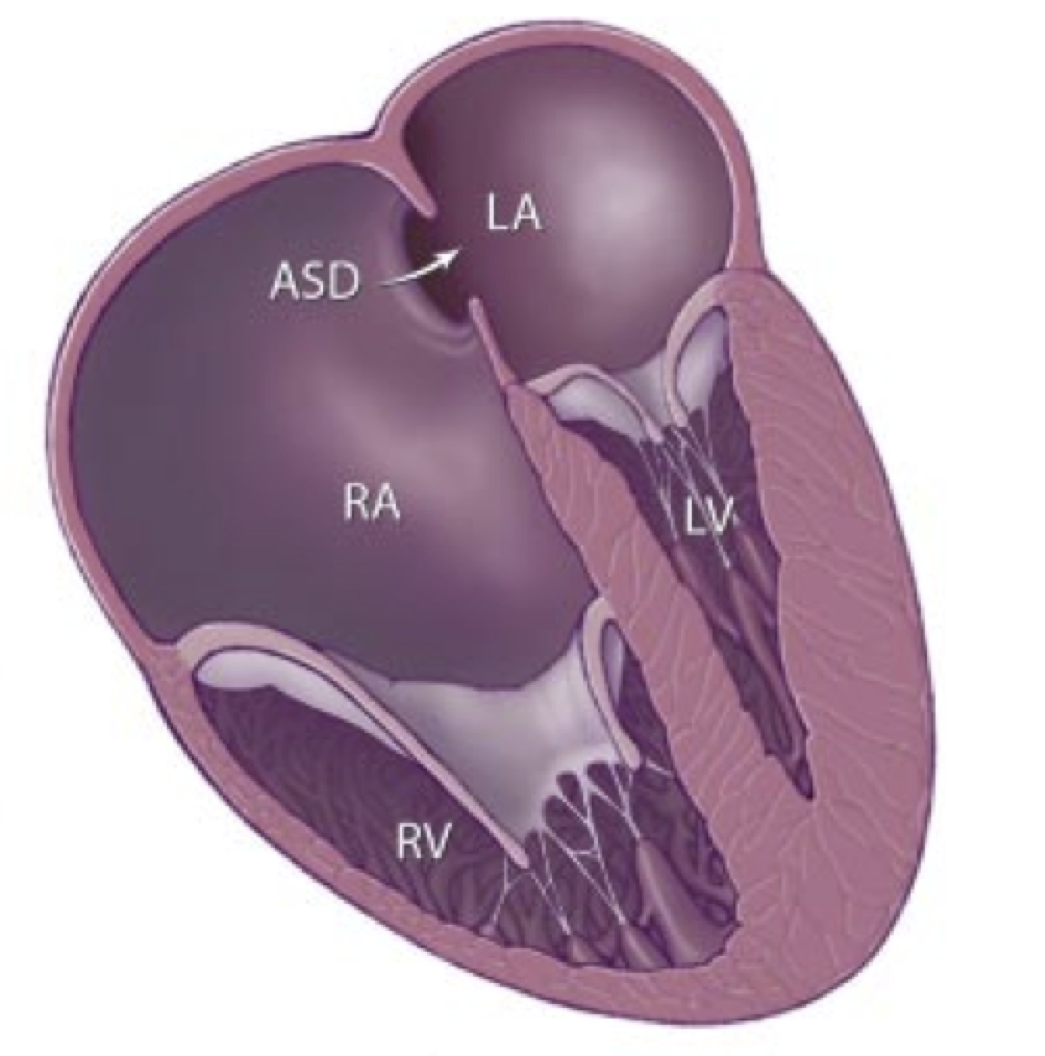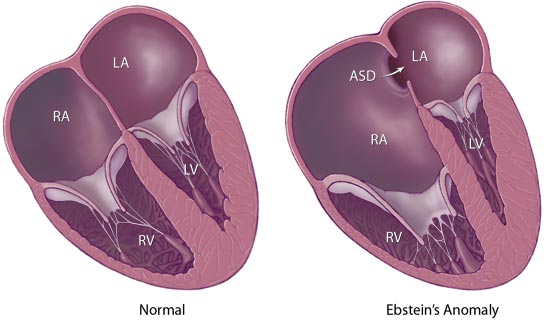WBR0514: Difference between revisions
Jump to navigation
Jump to search
No edit summary |
No edit summary |
||
| Line 23: | Line 23: | ||
[[File:WBR0514.png|center|400px]] | [[File:WBR0514.png|center|400px]] | ||
|Explanation=The picture is showing an atrialized portion of the right ventricle. The opening of the tricuspid valve is displaced towards the apex of the right ventricle of the heart (congenital apical displacement of the tricuspid valve that typically causes significant tricuspid regurgitation). This cardiologic malformation is known as Ebstein anomaly, which is highly associated with Lithium use during pregnancy. Lithium is used to treat bipolar disorder, which is characterized by intense depressive symptoms alternated with manic episodes (characterized by: distractibility, irresponsibility, seeks pleasure without regard to consequences (hedonistic), grandiosity-inflated self-esteem, flight of ideas-racing thoughts, in goal-directed Activity/psychomotor agitation, insomnia, talkativeness or pressured speech. | |Explanation=The picture is showing an atrialized portion of the right ventricle. The opening of the tricuspid valve is displaced towards the apex of the right ventricle of the heart (congenital apical displacement of the tricuspid valve that typically causes significant tricuspid regurgitation). This cardiologic malformation is known as Ebstein anomaly, which is highly associated with Lithium use during pregnancy. Lithium is used to treat bipolar disorder, which is characterized by intense depressive symptoms alternated with manic episodes (characterized by: distractibility, irresponsibility, seeks pleasure without regard to consequences (hedonistic), grandiosity-inflated self-esteem, flight of ideas-racing thoughts, in goal-directed Activity/psychomotor agitation, insomnia, talkativeness or pressured speech. | ||
[[File:Ebstein_diagram.jpg|center|500px]] | |||
<br> | <br> | ||
<font color="MediumBlue"><font size="4">'''Educational Objective:''' </font></font> bipolar disorder is treated with lithium, a mood stabilizer, which is associated with Ebstein anomaly, an atrialization of the right ventricle. | <font color="MediumBlue"><font size="4">'''Educational Objective:''' </font></font> bipolar disorder is treated with lithium, a mood stabilizer, which is associated with Ebstein anomaly, an atrialization of the right ventricle. | ||
Revision as of 16:34, 25 September 2013
| Author | [[PageAuthor::Gonzalo A. Romero, M.D. [1]]] |
|---|---|
| Exam Type | ExamType::USMLE Step 1 |
| Main Category | MainCategory::Anatomy, MainCategory::Behavioral Science/Psychiatry, MainCategory::Embryology, MainCategory::Pathology, MainCategory::Pharmacology |
| Sub Category | SubCategory::Cardiology, SubCategory::General Principles |
| Prompt | [[Prompt::A 1-year-old boy is brought by her mother to the ER because of difficulty breathing and cyanosis. The pediatrician on call orders an echocardiogram in order to confirm the diagnosis. The pediatrician on call is a professor at a prestigious university; therefore he uses his radiologic findings to create a picture of the pathophysiology behind the cardiologic malformation. The picture is shown below. Upon interrogation the mother states that he consumed a medication during her pregnancy to treat a psychiatric condition. She states that she started receiving prenatal care during the third trimester of pregnancy. Which of the following clinical presentations in her mother made her take the drug associated with the child’s condition?
 |
| Answer A | AnswerA::Mild episodes of increased shopping, rapid speech and insomnia lasting at least 2 years |
| Answer A Explanation | [[AnswerAExp::Incorrect. Cyclothymia is a milder form of bipolar lasting at least for 2 years, which commonly is treated with psychotherapy]] |
| Answer B | AnswerB::Hypersomnia, overeating, and mood reactivity |
| Answer B Explanation | [[AnswerBExp::Incorrect. This describes atypical depression, which is typically treated with MAO inhibitors]] |
| Answer C | AnswerC::Alternating intense sad symptoms with episodes of increased shopping, rapid speech and insomnia intense in nature |
| Answer C Explanation | [[AnswerCExp::Correct. See overall explanation]] |
| Answer D | AnswerD::Recurring intrusive thoughts, feelings, or sensations that cause severe distress; relieved partly by repetitive actions |
| Answer D Explanation | [[AnswerDExp::Incorrect. This refers to OCD (Obsessive compulsive personality disorder) which is commonly treated with SSRIs]] |
| Answer E | AnswerE::Excessive and unreasonable fear that interferes with normal function |
| Answer E Explanation | [[AnswerEExp::Incorrect. This refers to specific phobia, which is treated with SSRIs]] |
| Right Answer | RightAnswer::C |
| Explanation | [[Explanation::The picture is showing an atrialized portion of the right ventricle. The opening of the tricuspid valve is displaced towards the apex of the right ventricle of the heart (congenital apical displacement of the tricuspid valve that typically causes significant tricuspid regurgitation). This cardiologic malformation is known as Ebstein anomaly, which is highly associated with Lithium use during pregnancy. Lithium is used to treat bipolar disorder, which is characterized by intense depressive symptoms alternated with manic episodes (characterized by: distractibility, irresponsibility, seeks pleasure without regard to consequences (hedonistic), grandiosity-inflated self-esteem, flight of ideas-racing thoughts, in goal-directed Activity/psychomotor agitation, insomnia, talkativeness or pressured speech.

|
| Approved | Approved::No |
| Keyword | WBRKeyword::Ebstein anomaly, WBRKeyword::Lithium, WBRKeyword::Bipolar disorder |
| Linked Question | Linked:: |
| Order in Linked Questions | LinkedOrder:: |